The
introduction - that like a spiraling tower kindles the slumbering
consciousness to the threshold of ecstasy - develops within the tension
of the tonic f# (b. 1) - c (b. 32) polarity. Formally speaking,
it can be compared to a large anapaest. This is the form whose rules are
taught to the knight Walter by Hans Sachs in Act III of Die Meistersinger:
two "Stollen" should follow one another, the second "just like" the first,
"so that they can see that they're choosing a wife like themself to marry".
The "Stollen" sections are then rounded off by an "Abgesang": "If you've
succeeded in finding a true pair, it will show in the children". The Abgesang
should provide the sections with an ending "so that nothing shall fall
out of place". Allegedly Bartók began to use this form (Barform)
after being influenced by the writings on Wagner by Lorenz; its
clear structure can easily be seen in all three movements of the Sonata. In
the following, we shall call it anapaest form, due to its
formal make-up (Antecedent I, Antecedent II, Consequent) and its quality
of straining onwards. The two "antecedents" are equivalent to the short
stresses of the anapaest, while the "consequent" is analogous to the long
(accented) one. Its onward straining character, or "wildly drifting", as
Kosztolányi 20) called this metrical
foot - which certainly is dynamically forward looking - can be attributed
to the "long syllable", the consequent, which almost mirror-like, grasps
the material of the antecedents and absorbs it in a condensed form. In
its structure and internal logic, Bartók's
anapaest is above
all related to the formula of Hegel's axiom "thesis - antithesis - synthesis".
Antecedent
I (1st Stollen bs. 2-8) is coiled round the tonic axis, antecedent
II (2nd Stollen bs. 8-11) round the dominant axis, and the consequent
(Abgesang bs. 12-17) round the subdominant axis. In the antecedents,
the leading motive appears rectus; in the consequent, inversus.
The f# timpani tremolo in antecedent I, in a spirit of obscurity
and motionlessness, emerges on the tonic counterpole. The vaguely
swirling entries on
f# in P.I - fully exhausting the variational
possibilities - fall on the first, third and second eighth note of the
triplet groups. The tonic main note,
c is heard only in b. 5 in
the 2nd piano. There follows a twofold answer at the fifth 21)
: the entries on g-db in
antecedent II (again counterpoles, P.I b. 8; P.II b. 9) rest on the dominant
axis; the
ab-d
mirror progressions 22) of the consequent
(from b. 12) on the
subdominant axis; in bs. 14-17 in P. I, the
leading motive, clinging to the g# (=ab)
- d counterpoles - right and left
hands confronting each other in mirror inversion - becomes increasingly
dense through a paring down technique (in b. 13 the thematic idea is still
complete, later reducing its range to 7, 6, 5, then 4 notes), so that the
approaching side drum roll can rouse the music to an unheard of pitch of
excitement and suspense. From b. 18, the rolling current of the melody
in P. II has its surface sharply broken up by the P. I. Deep down, behind
the primitive barbarism of the b-f timpani ostinato, an elemental
instinctive dynamism throbs which cannot fail to arouse in the listener
the feeling that danger threatens. From now on there is no stopping: an
energetic outburst of the bbb chord
(from b. 26) brings to mind something Schumann wrote: "Once in the C minor
Symphony (Beethoven), during the transition leading to the last movement,
while every nerve was strained to bursting point, a little boy nestled
increasingly close to me, and when I asked him why, he answered: I'm frightened!"
It
is characteristic of a
chords that they can always be broken up into at least 2 layers ("axes"),
e.g. a c a chord into the notes c-eb-f#-a
of the tonic axis, and bb-g-e-c#
of
the dominant axis, where the latter acts as the
shadow of the tonic
(cf. "Interval Symbolism" §6):


This
illustrates that cadential harmonic progressions are created by stratification
of the axes, and may be illustrated as a circular process, where every
link in the chain changes into the "shadow" of the new function at each
successive stage.

In
classical harmony these are called common notes; expressed diagrammatically:

Hence
from b. 18, above the subdominant axis, is the dominant axis
strata, in the form of a bbb
chord:

(Which
is why the timpani stay on the b-f subdominant tritone.)
Most
interestingly, from b. 21 onwards Bartók constructs this same bbb chord
from its elements practically before our eyes,

which,
as the Bartókian dominant of the tonic c, serves to prepare
for the first subject (the first subject of the recapitulation is also
prepared by the bbb chord,
b. 273). Vertically, the intervals in b. 18 are purely GS ones; in the
following bar these intervals are inverted, and together with the inversion
the harmonic character of the music is also changed.

The
secret of the dynamic effect of the introduction (bs. 1-31) is largely
due to its thematic opening up, which gradually bends the "circular motion"
of the motive-work at the beginning over into the tense "straightening
up" of bs. 26-31:

(Already
in b. 17, the first such thematic straightening up appearing above
the side drum tremolo is accompanied by exceptional tension.)
To
help characterize the bars omitted so far (6-7 and 10-11), an extract suggests
itself from the Rigveda: "All was black, as when it is night, Time was
just an ocean in the making (bs. 1-5); And then the One, that was sleeping
there in its shell, Became alight and flamed out of its covering (b. 6)."
The "flaming out" cymbal stroke produces a sharp duality in both first
sections, in fact, following a striking chain of fourths, it also
turns out that the flaming out in the consequent will be the first subject
itself: d in b. 6, g in b. 10 and c in b. 32!
Bar
6 is, in reality, the implementation of the subdominant axis (P.I central
d, P.II top g# 23)). The symmetrical
scale (P.II espressivo) of the modulation
from the subdominant axis
(b. 6) to the dominant axis (bs. 8-9) is a synthesis of the notes d-f-ab
of
the subdominant axis and c#-bb-e
of the dominant axis.
The
dominant g in bs. 10-11 still lingers in the background, more precisely
in the form of the g-c# axis (P.II, together throughout with the
mystic strokes on the tam-tam), forming a strata beneath the P.
I:

OUTLINE TABLE
OF THE INTRODUCTION:
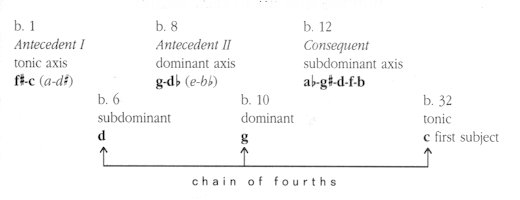
EXPOSITION
(bs. 32-160). The first subject (bs. 32-80), bursting with pagan
joy, is rooted metrically in the leading motive, whose motivic stresses
(see analysis of b. 2) conceal the rhythm of the first subject:
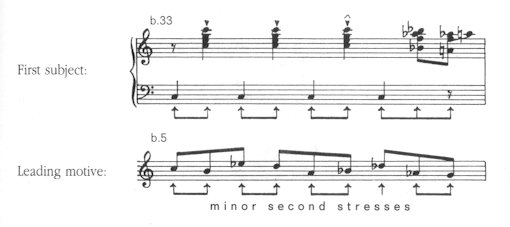
The
essence of the rhythmic content is thus the negotiations and inevitable
conflict caused by the duplets uniting into the triplet time - mathematically,
the relationship between the numbers 2 and 3 - which in the case of the
c leading motive is intensified harmonically by the db note,
and the db-g
dominant axis disrupting the c-eb-a
axis (minor second rhythmic stresses!).
The
first subject confronts us with the symmetry of a main section (bs. 32-40)
- middle section (bs. 41-60) - main section (bs. 61-79).
Resting
on the tonic c in the timpani, the treble of main section I (bs.
32-40) periodically increases its range: in the first segment it is the
third c-a (b. 33), in the 2nd segment, the fourth f-c (b.
35), in the pentatonic 3rd segment, the sixth ab-b
(b. 37), and in the similarly pentatonic flavoured 4th segment, the seventh
f#-g (b. 39). Its harmonic stages are the following: the notes
of the tonic axis c-f#-a in bs. 32-34, the tonic axis eb-c-a
in bs. 35-36 and the subdominant axis ab-b-f in bs. 37-38, b. 39
being woven around the tonic f# counterpole. Thus the melody's climax
is on the summit-like sixth of the tonic (b. 37).
In
relation to the central c, the turning points of the theme are constructed
of intervals increasing in GS succession: minor third (b. 33 a),
minor third and perfect fourth (b. 35 eb
and
f),
and minor sixth (b. 37 ab);
expressed numerically, the proportions 3, 5 and 8 (after which the counterpole
appears, b. 39). All this is completed organically by the diagram of the
melodic range of the first subject:

The
melodic ranges of the leading motive also reveal a similar GS structure:

In
the flexibly expanding and contracting chain of chords in bs. 37 and 39,
there is a continual interchange of pole and counterpole, e.g. in b. 37
the ab fourth
chord and dg chord
(incomplete: f#-d-f), - eb fourth
chord and ag 24).
The
middle section (bs. 41-60) is enmeshed in the d-ab
subdominant axis, consigning the
first subject to the side drum parts, giving way to a brilliantly sharp-edged
continuation of the leading motive. The thematic idea achieves its
full form gradually: in bs. 42-44 only the two opening notes of
the tip of the motive appear 25)(d-c#),
in b. 45 three notes from the motive appear (d-c#-f), and finally
in bs. 47-48, the whole
leading motive emerges (d-c#-f-e-b-c-eb-bb-a).
The digression to the sharp-sounding ab
in
b. 45 lights up the counterpole of "d" (!!); the subdominant axis
is also reinforced by the abg chord
in P. II.
The
broad harmonic picture of bs. 41-49, therefore, is the following 26):

In
bs. 50-57 all this appears in inversion - through the d-ab
subdominant axis-poles and the
two pianos changing places. The changes of harmony are created by cadential
"stratification" (cf. analysis of b. 18), thus the upper strata of the
new chord (dba)
is the dominant axis, the lower strata the subdominant axis just preceding;
for this reason too, the theme - which continues in the subdominant axis
(ab-d)
- is this time beneath the accompanying harmony.

Main
section II (bs. 61-79) brings again to the surface the first subject
and the
tonic axis: the P. I dressed in the tonic a minor,
c major and f# minor harmony turns on notes from the tonic
axis - in bs. 61-62 c, in bs. 63-64 eb-c,
in bs. 65-66 a-f#-eb,
in b. 67 a-c and in bs. 68-69 a-f#. The notes of the tonic
axis in the undulating progressions in the P. II are in bs. 61-64 a
and bs. 65-68 f#, while in the timpani f#. At the centre
of the treble in P.I bs. 65-66 lies the tonic f# counterpole:

Similarly,
the
c pole in b. 67 is encircled by c#-b.
Main
section II, therefore, taken as a whole, is, like main section I, built
on the polar tension of c and f# (bs. 61 and 65).
The
overlapping entries in bs. 69-72 move within a circle of fifths (P.II b.
69 a-d-, b. 70 g-c-, b. 71 f-bb-,
P.I b. 71 eb-,
b. 72 ab-,
P.II c#). The meeting of the parts produces a-type harmony:

The
first subject's raw flashes of light and the middle section's bleak subterranean
murmurings with their ghostly tappings, both distant and near, are reminiscent
primarily of the atmosphere of Moussorgsky's "Night on the Bare Mountain"
(we think that the rhythm itself of the first subject is related to that
of the dance infernale in Stravinsky's "Firebird").
OUTLINE TABLE
OF THE FIRST SUBJECT:

There,
then, commences a contest of the axes. Primacy - according to the rules
governing the second subject of a sonata exposition - belongs after
all to the dominant (b. 73 is a d-f-g#-b subdominant axis
coloured by leading notes; b. 74 is an a-f#-eb-c-a
tonic
axis; b. 75 is a g#, d-f-g#-b
subdominant axis; b. 76 is an eb,
a-f#-eb-c
tonic axis; and finally from b. 77 there is an e-g-a#-c# dominant axis).
The
bridge between the first and second subjects has an unusual atmosphere
- distant flashes
27)
discharging and recharging
on the dominant c#-g counterpoles (bs. 80-83). The notes heard below
the c#-g, which populate the strange atmosphere with mysterious
echos (the g#-d axis on the timpani, the 2nd piano's "silence-wrinkling"
d, together with the 1st piano's
d and
g# parallel
major sevenths) reveal an a
structure:

The
rhythmic layout of the broadly phrased second subject 28)(bs.
84-104) is related to the metre of the first subject, which breaks through
the beats of the bar (especially the second subject in the recapitulation
bs. 292-325 and at the beginning of the development bs. 161-170):

moreover,
it can be considered to be the complementary rhythm of the first subject.
On
its magical course, the second subject evolves through a truly wide range
of scale-expansion, spanning the diatonic (b. 84) to the pentatonic
(b. 88), pentatonic to motivic-work in broad fourths and fifths (bs. 95-98),
and then to the sixth progressions of the closing theme (from b. 99).
The
note-row of the melody in bs. 84-87 is attached to the dominant axis:

From
the outline, it can be seen that the position of each individual degree
of the scale is determined by where the dominant axis - emphasized
by the turning-points
e and f x
- and the answer at the fourth join. (Through the melody, transpires
the major-minor chord e-f x-g#-b.) In the organ
point on the dominant (in relation to e) in the 2nd piano appears
the "lower" strata of the harmony.
By
contrast, the melodic line in bs. 88-91 avoids the road so far travelled,
allowing the tonic axis c-eb-a-f# 29)free
play (bs. 89-91). In the 2nd phase (bs. 95-104), the subdominant
axis pushes powerfully forward (P.I abtrill
and timpani ostinato d, P.II theme in ab with
final on b-d and bg chord
from b. 99). The note-row of the melody in bs. 95-96 also arises from symmetrically
circumscribing the subdominant poles d-ab:
g-ab-a
and db-d-eb,
to be exact, as follows

The
melodic curves follow each other at the fourth: subdominant counterpoles
ab-d
(95),
tonic counterpoles eb-a
(96)
and dominant counterpoles
bb-fb (97).
Not
to be forgotten, also, are the note ranges of the second subject,
in which once again only GS intervals are allowed scope - in section I
the augmented octave
f#-g ("13"), in section II the major thirteenth
d-b ("21"):
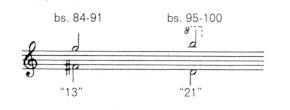
If
we combine together the note ranges of the leading motive, first subject
and second subject, we see a clear GS relationship:
| leading motive |
8 : 5 : 3 |
| first subject |
13 : 8 : 5 |
| second subject |
21 : 13 |
The
proportions 3 : 5 : 8 : 13 : 21 contain the purest GS numbers.
The
c# final of the first subject (b. 80), the f# final of section
I (bs. 91-94) and the b final of section II (bs. 99-104, b
major-minor) succeed one another in a chain of fourths, in preparation
for the tonality of the closing theme.
Section
I of the second subject, based on the Bartókian dominant e (from
b. 84) 30) and section II, based on the
Bartókian subdominant ab(from
b. 95) together with the tonic c stand in an augmented triad relationship
(c-e-ab),
its structure thus being founded on the equidistant division of the tonal
system. The runs digressing from the trill in section II also suggest the
formal links between ab
and
e
(bs. 95-98). A similar structure is evinced by the development section,
split in two by leading motive ostinatos on e (bs. 195-216) and
g#
(bs. 232-259).
OUTLINE TABLE
OF THE SECOND SUBJECT:
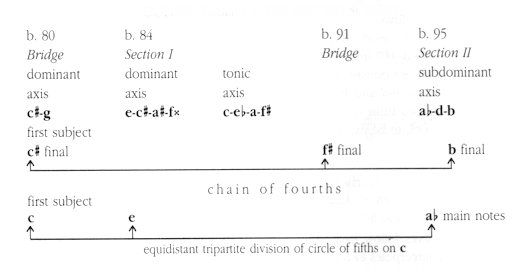
"Ascending
metrical feet rushing towards a mysterious destination" - this is how Kosztolányi
32)
characterized a poetic line with a similar stress-pattern to that of the
closing
theme. The two steep inclines of the closing theme (sections I and
II) stare at us like the swaying dance in the "Feast Spoilers" by János
Arany 33), which, following the diabolic
musician's bagpipe, becomes faster and faster, ever more tempestuous and
unbridled, driving the frenzied crowd into hell; or like the rampaging
army of ghosts in Goethe's "Sorcerer's Apprentice", released from their
bonds by the spell and surging on irresistibly.
Section
I is a single exciting anapaest outline (antecedent I b. 105, antecedent
II b. 115, consequent b. 123-132). Bars 105-108, which initiate the closing
theme, are rhythmically an augmentation of the first subject:

The
"primal motions" of section I (bs. 105-132), prancing on d-b (from
b. 105), taking a partner on d#-f# (from b. 115) and on bb-g
(from b. 123), are from a note-row with an intertonal augmented triad
structure:

and
the entries overlapping in bs. 123-132 merge to form a 1:3 model
(eb
=d#). The
b g
chord in bs. 105-117 also submits to this relationship. The first entries
fall into the sphere of the subdominant function, the second into
that of the tonic function, and the third into that of the dominant
function. Taken separately: bs. 105-114 (disregarding the tonal
digression in b. 110) are on the subdominant axis; broken chord versions
of b g (105-107
and 112-114), g#d
(108),
ba
(109)
and
da
(111)
are heard:

The
change of harmony in bs. 115 and 118 comes as a two-directional answer
at the fifth to the d-b entries: g-e (left hands) and d#-(instead
of a as a result of the mirror-progression) f#. The harmonic
change itself is heard as f#a,
and in bs. 119-120 as ca counterpole:
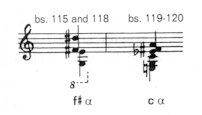
The
dominant axis-influence in bs. 123-132 can be seen only in terms of the
entries on bb-g,
since its three building-blocks (bb-g,
eb-f#,
d-b)
each represent a chain-link from one of the three axes; even so the dominant
function remains in the form of the g-bb-b-d
dominant major-minor chord (actually g g) situated at the peak of the crescendo.
OUTLINE TABLE OF SECTION I OF THE CLOSING THEME:

With
section II - also 28 bars long - we arrive at a formidable precipice (b.
133). Again, the 1:3 model appears: d-f-f#-a-bb-c#,
accompanied by eerie glissandos on the timpani which evoke an almost "acoustic
panic". Via the rhythmic accents, there stands out from the model a d-f#-a-c#
chord, as signature, which in the manner of a cryptogram accompanied Bartók
throughout his life. Relevant works are: the theme of the early Violin
Concerto; the thematic material of the Two Portraits - Ideal and Grotesque;
no.3 of the Three Hungarian folksongs from the Csík district (bs.
3, 4, 6! and 8); no.13 of the Bagatelles "elle est morte" (enharmonically
a-gb-d-db)
and no.14 "ma mie qui danse" (bs. 9, 179-209); Dedication (bs. 1-4) and
no.7 Dawn (bs. 8-9) from Ten Easy Pieces; with the chord symbol in broken
form: the repeated f#-c# phrase in no.1 of the Peasant Songs and
the d-a back-bone of no.2 Frustration; Portrait of a Girl (bs. 4,
14, the main notes in LH bs. 43-51!, 53 and 64) in Sketches; Allegro Barbaro
(bs. 136-137); the other-worldly organ music heard in the closing scene
of Bluebeard's Castle; no.14 of the 15 Hungarian Peasant Songs (bs. 17!,
29-30, the bass in 23-24; and probably the 1st version f# minor +
the 2nd version D major = d-f#-a-c#); no.70
Melody against Double Notes (last bar) of Microcosmos; etc.
Interestingly,
not only can the "Bartók signature" be extracted from the 1:3 model,
but also the motive which in his youth Bartók called his "Leitmotiv"
34)(c#-e-g#-b#),
and even more importantly, the g chord itself as well 35):

But
let us return to section II of the closing theme. The chromatic "opening
up" and "closing up" of the 1:3 model produces a 12-tone construction
in bs. 134-137 (in the diagram, the upper and lower models coincide
in terms of their scalic composition):

The
process is repeated in b. 139. The diminished sevenths in bs. 138 and 140-141
make a chords:
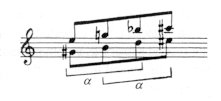
With
sharply defined accents, the musical current flows into the augmented
triad b-eb-d#-g
of the second period (b. 142), the notes of which provide the starting
points of diminished sevenths (b. 143 from b and d#
P.I, from eb and
g
P.II;
b. 146 from
eb and
g
P.I, from b and d# P.II); the intervening scale-progressions
are also governed by diminished sevenths (P.I bs. 144-145 f#-a-c-eb,
bs. 146-147 bb-c#-e-g,
bs. 150-151 c-eb-f#-a
on the triplet beats; the parallel left hand and P.II may be analyzed similarly).The
structural principle, therefore, is once again the GS (or a), because the augmented triad mentioned is made from minor sixths (8+8+8),
and each one of its notes is connected to a diminished seventh (3+3+3+3):
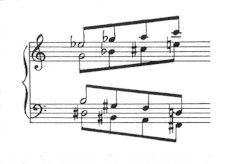
We
see here a continual process of complication in the texture, the overlapping
of harmonic levels - we might call it a general disorganization. This is
a logical continuation of the internal expansion of the exposition, referred
to already in connection with the succession of leading motive - first
subject - second subject. Axis (= diminished seventh) presses against axis,
indeed in the struggle of the 3rd period, they intrude upon one another's
form:

The
colliding waves of sixths in the 4th period (bs. 154-160) traverse the
keyboard along an ever-widening course 36)
above the ominously advancing timpani. The appearance of the second subject,
which begins the development section and resolves the destructive force
of the heightening tension, is a very characteristic turn of events - in
the words of Antal Molnár 37)- "as
if Bartók at the climax of the suspense suddenly cast a spell and
fixed into a motionless state the churning world". Such "unexpected transfigurations"
are always prepared by Bartók with the upper minor second
of the approaching keynote - in this case, at the end of b. 160 the e
second subject with fb,
so that instead of the expected bb,
it resolves surprisingly onto its counterpole 38)(thus
the second subject, as if nothing had happened, can again appear in e).
In the axis system, let us remind ourselves, the upper minor second of
the tonic always has a dominant meaning.
The
design and shaping rhythm of the whole exposition (including the introduction)
is
none other than the rhythm of the first subject projected widely onto a
broad surface. The "introduction" moves towards the forte-fortissimo in
b. 18, then on to the entry of the first subject in b. 32; the restrained
dynamics of the middle section of the first subject (b. 41) again burst
out with elemental force when the main section returns (b. 61); the p
volume that characterizes the second subject twice advances in the closing
theme (sections I and II) from p to ff. If we regard the
introduction as the first triplet of the first subject's three triplets
(= 9/8), the second being the first subject and the third being both the
second subject and the closing theme together, then the undulations of
the dynamics and the accentuations of the first subject coincide:

It
is no coincidence that the whole progress of the exposition is forward-looking,
rising upwards, and that at the climaxes it subsides, beginning anew its
attempt to rise again. In almost every detail, exactly the same thing is
happening within the smaller formal units as on a larger scale - an overall
interval expansion. These processes continue to undulate onwards,
as far as the central point of the movement (217), after which they turn
around, allowing in their place, downward curving dynamics and interval
diminutions (for more detail v. the end of the analysis of the recapitulation).
It is interesting to what extent this duality has an effect upon
the mood of the first and second halves of the movement. For example, there
is almost no place among the threatening interval expansions of the first
part, verging on the irrational, for a statement like the burst of laughter
in bs. 239-41, and 245-47 (diminishing funnel-shapes), or the "human" espressivo-speech
in b. 317 (note-row contracting into the chromatic scale).
The
inner expansion of the exposition is followed faithfully by its harmonic
structure as well: the chords of the first subject, the middle section
of the first subject, the second subject and the closing theme succeed
one another in stages of expansion in GS order. The character of
the first subject is provided by pentatonic harmony (e.g. b. 35 eb-db-bb-ab
also found in the melody: bs. 37 and 39) whose formula might be expressed
thus: 2+3+2, namely major second + minor third + major second. Throughout
the middle section of the first subject, there is the g formula 3+5+3 -
minor third + perfect fourth + minor third (from b. 41 c-eb-ab-b,
the f# further dividing the fourth eb-ab
in
the proportion 3+2). The second subject is always associated with parallel
fourths and minor sixths 39): 5+8 (particularly
evident from b. 95), finally the closing theme being accompanied throughout
by parallel minor sixths: 8 (bs. 134-160).
To
sum up, therefore:
| first subject |
2 : 3 : 2 |
| middle section
of first subject |
3 : 5 : 3 |
| second subject |
5 : 8 |
| closing theme |
8 |
DEVELOPMENT
(bs. 161-273). The development section forms an organism unique in its
organized
symmetry. The formal structure is cut in two - with numeric
accuracy - by the climax in b. 217; the two sections are welded into a
firm unity by the kinetic ostinato of the leading motive, rectus
in section I (b. 195-216) and inversus (b. 232-261) in section II;
not to mention the harmonic unity, which draws section I into the magnetic
field of the dominant axis, and section II into that of the
subdominant
axis. The leading motive ostinatos centred around the
e and
g# poles divide proportionately the circle of fifths, intersected
by the tonic
c40)(an augmented triad
structure c-e-g#
resembling that of the second subject):

Here
it seems opportune to digress and consider what a decisive effect the technique
of "theme and inversion" has had on the whole thematic structure.
It is worthwhile tracing the mirror-progressions, by quoting merely
the most striking instances: movement I bs. 2 and 12, 43 and 51, 105 and
115, 135, 161 and 166, 175 and 179, 195 and 232, 239 and 244, 248, 332
and 360, 386-397, 433 and 435; movement III bs. 5 and 8, 44 and 56, 74,
134 and 139, 145 and 153, 160 and 163, 207 and 212, 217 and 223, 351 and
353, 379 and 381, and 387 and 389. It brings to mind Bartók's humorous
letter 41), at the end of which the composer
tacked on two fairly fat treble clefs in such a way that the second, exchanging
its right and left halves, is a reflection of the first. The difference
is that what, in the letter, was a game or self-mockery, has here immediately
become a grammatical and stylistic rule - "a musical life-form" - indeed,
practically a distinctive feature of Bartók's compositional style.
At
first sight, bs. 161-195, which bridge the exposition and the e
ostinato, stand in the way of a logical realization of the symmetry. It
turns out, however, that the minor second note-row (bs. 161-163)
concealed within the second subject, which constitutes the entire material
of the thematic work even in bs. 175-194, is in fact a separate treatment
of the minor second cells of the leading motive ostinato (cf. bs.
42-57 and analysis of b. 2!), that is, in essence, a preparation.
Tonally also, the preparatory section shows that it is wholly related to
the main section joined to the central e, or the dominant axes:
"e" second subject 42)(from bs. 161
and 166) with answers at the fifth = fourth (b. 162 P.II: a; b.
167 P.I: b) and trill on e (bs. 166-181). 43)The
phrase endings of the second subject dissolve into characteristic a
colours: b. 164 ag(c#-e-g-a-c),
end of b. 165 g#b(a-b#-d#-f#-g#),
- b.
169 g#g(b#-d#-g#-b),
b. 170 dg(f#-a-d-f).
The
cupola-shaped bs. 175-194, which come to a build-up and then drain away,
outline a "presto-pizzicato whispered as if half-dreaming":

By
a deliberate expansion of intervals, the following equidistant
octave divisions44)are created in succession:
1. whole-tone scale (major second intervals) 2. diminished seventh chord
(minor third intervals) 3. augmented triad (major third intervals) 4. augmented
fourth chord (augmented fourth intervals). This, in fact, is the geometrical
distribution, followed by the internal expansion, of the rows of minor
seconds in bs. 175-181 (in the diagram "A + A inverted"); the intervallic
growth points towards the climactic "B":
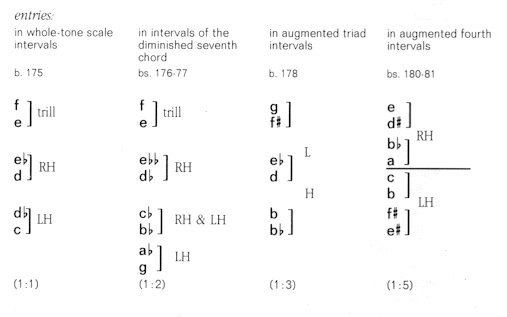
As
can be seen from this diagram, there is a 1:1 - 1:2 - 1:3 - 1:5 GS relationship.
The
starting point of the "A" formal sections is the db-c#
dominant
pole(bs.
175, 179 and 190-194). The dominant axis is also reinforced by the downward
line in P.I bs. 178-179 (triplet beats bb-g-fb-db-a#-g).
On
the one hand, a repeat of the whole-tone scale is required by the position,
in the form of "A" inverted (b. 179): bs. 179-181 f#-e# 45)(LH),
e-d#
(RH),
d-c# (RH), c-b (LH), bb-a
(RH); on the other hand, augmented fourth relationships are required,
which, true to the scheme, put themselves forward: bs. 180-181 e-d#,
bb-a
(RH), and
c-b, f#-e#,
c-b (LH).
Then
follow bs. 182-190, marking the peak ("B"), moving along the most wide-ranging
equidistant chord, in the circle of fourths: on the descant triplet
beats in P.I b. 182 f-c-g, b. 183 g-c-f, b. 184 f-c-g-d,
b. 185 d-g-c, bs. 186-187 f, b. 188 c-g-d, b. 189
a-e-b, b. 190 f#-c#, the latter leading back to the opening
b. 175 ("A":
c#-b#=db-c).
The harmonic background is parallel fourth chords in 6 layers (b.
182); the falling pairs of 4-part fourth-chord figures in bs. 188-190 bring
into conjunction the most distant keys (pole-counterpole relationships;
e.g. b. 188 P.I c and P.II f#).
Bs.
191-194 ("A") approach from two directions the "e" ostinato appearing
in b. 195 (soprano: c#-d-d# ®
e; bass: f x-f#-e# ®
e).
Section
I (bs. 195-216), which gravitates towards the climax in b. 217, assumes
again
anapaest form: the antecedents (I bs. 198-202; II bs.
203-207) push upwards, partly chromatically (bs. 198 g- ,
203 g#-a- , 204-206
bb-b-c-
,.208 c# ), and partly by means of the
answer at the fourth
(the fourth equivalent of bs. 200-202 eb-db-cb-a
is bs. 205-207 ab-f#-e-d);
the consequent meanwhile employs systematic interval expansion:
P.I c# LH b. 208, minor second: b. 209 d, major second: b.
210 e, minor third: b. 211 g, major third: b. 212 b,
perfect fourth: bs. 213-216
e (also, the relationship between RH
and LH periodically increases).
The
a final in antecedent I (b. 202) and the d final in antecedent
II 46)(b. 207) are the upper fourths of
the "e" ostinato, and the timpani strokes on b (from b. 204)
and f# (from b. 208) as well as the increasing number of parallel
chords in the P. II, are the lower fourths of the "e" ostinato.
The inarticulate "whooping" and "cheering" of bs. 200-202 and 205-207,
which motivically have their roots in the closing theme, are redolent of
an almost elemental, rhythmic, ancient state of human speech, in which
the sound has not even become fixed (here stem the chromatic patterns:
eb-d,
db-c,
cb-bb,
a
and ab-g,
f#-f,
e-eb,
d).
47)
The
centrally positioned "e" ostinato (P.II) that sounds throughout, is entrenched
systematically by the dominant axis: antecedent I emerges from the poles
g (b. 198) and bb
(bs.
200-202); (the answer at the fourth in antecedent II of necessity opens
up a different harmonic strata), and the intervallic growth of the consequent
extends from the poles c# (b. 208) to e (bs. 213-216):

In
b. 200 the tension of the eb is caused by the b
relationship with the preceding part:

Towering
over the development, bs. 217-224 give still more emphatic expression to
the
apex-like quality of the sixth: namely, that it is on the sixth
g#
(=ab)
and a (xylophone) of the tonic c that the development section
comes to a head, b. 217.
The
penetrating thematic line and the accompanying waves of thirds alternate
bar by bar between the two pianos. The entries of the theme (disregarding
the
c# fifth-shift) underline the subdominant axis. From
the a
structure, attention should be drawn to the initial subdominant fg in
bs. 217 and 221, and the similarly subdominant d g in
bs. 219 and 223:
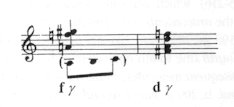
The
accompaniment of the first partial phrase - as the counter image of the
expanding bs. 208-216 - makes use of contracting intervals: on the
triplet accents
a-d-g fourths (P.II b. 217), c#-a-f major thirds
(P.I b. 218), b-d-f minor thirds (bs. 219-220). The last-named,
two bars, hurrying through the subdominant axis barriers, permit
the conclusion that in the accompaniment of bs. 217-218 we are in fact
dealing with an appearance of the subdominant axis, taxonomically overstrained.
The
material binding the augmented triad g-b-eb =d# that forms the framework
of bs. 225-228 (on the triplet beats) strives for maximum equalization
in its use of chromaticism: in both RH parts ascending and descending progressions
evade one another's path (cf. further bs. 217-218); the whole-tone scales
in the LH parts are woven together along the same principles: bs. 225-226
eb-f-g-a-b,
c-bb-ab-gb-fb,
etc.
In
the accompaniment to the high voltage sparks of the b#-f# tonic
axis that lies at the tonal mid-point of the central e and g#
in the development, there appears the g# leading motive ostinato of
section II, and even more powerfully, the subdominant axis (in
bs. 232-234 P.II the c#-d# are the upper and lower fourths of the
g# ostinato; they only have to close up for the counterpole d
to appear, b. 235).
Section
II is a variation of the first; for the sake of comparison, the
relevant bars have been placed below each other:
| Section I. |
b.: |
198 |
200 |
203 |
205 |
208 |
| Section II. |
b.: |
235 |
239 |
242 |
244 |
248 |
indeed,
b. 217 is none other than the formal projection of b. 161 (development
of the second subject).
The
funnel-shaped formations in bs. 239-241 and 244-247 that germinate
from the thematic and rhythmic material of the closing theme, become wedged
in between the "main-branch" (d-g#) and "sub-branch" (f-b)
of the subdominant axis:
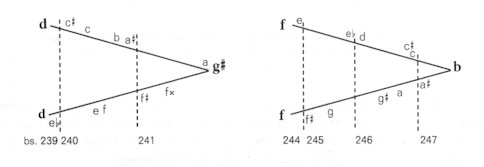
The
broad gestures of the ebullient funnel-shaped progressions (exultant xylophone!)
break free from the contracted chromaticism of bs. 235-238 and 242-244
- positioned around the d-f-b subdominant poles.
A
double answer at the fourth leads, via the dominant (g bs. 248-251,
c#-e-g = f x-bb
axis
b. 251), to the tonic (c bs. 252-255, f#-a-c-eb
axis
b. 255). bs. 256-261, which condense the imitative mirror technique (bs.
248-255) into simultaneous motion, then focus their own passages, opening
and closing like scissors, around the d-f and g#-b poles
of the subdominant axis
again. The behaviour of this texture, with
its expanding and contracting shapes, is like a flimsy wall trying to resist
the recapitulation ready to break through, and already tearing a hole in
it. The subdominant axis still manages to fix ahead two exclamation marks
(P.II bs. 260-261), during which the g# leading motive ostinato
gives way to its counterpole, whose d-g outline - on the way to
the tonic - is sounded by the timpani; finally the sigh on d-c#
in b. 263 signifies the extinction of the subdominant axis; 48)
the tonic is arrived at in stages via the fourths in the timpani, which
throughout underlines the central g# (bs. 264-270 eb,
bs. 270-273 bb-
f
in P.II b. 273 - and b. 274 c), and is prepared from a different
direction by the complete circle of fourths in the two pianos: entries
on c bs. 264-266, f b. 267, bb-eb
b.
268, g# b. 269, c#-f# b. 270, b-e bs. 271, a-d
b. 272, g b. 273 and c b. 274.
OUTLINE TABLE
OF THE DEVELOPMENT:
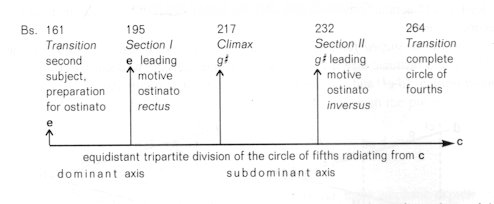
RECAPITULATION
(bs. 274-416). The eruptive outbursts of the first subject of the recapitulation
break the crests of four waves - as in the exposition; it is the descant
of sections 1, 2 and 4 that follows most closely the material of the exposition
(cf. bs. 32-40). The explosive, bulging shapes stretch along a spiral of
fourths:

To
be more exact, the climactic section 3 unites and complements the above
outlines 2 and 3 to form a melody - coming to rest on the tonic c main
functional note - so that section 4 can plunge into the tonic f# = gb
counterpole (286 fff), the structure,
in this way, once more having the polar framework
c (274) - f#
(286). The first piano holds on to the tonic poles
gb
(286)
and eb
(287);
b. 288 is the fourth-like continuation of b. 286 - and b. 289, the similar
continuation of b. 287 (alternate rhymes; it should be noted that the beginning
of b. 287 has an ebb
-like harmony, and the 2nd eighth
note of the following bar has a bb-like
harmony). Eventually, in bs. 290-291, we arrive at the tonic f#-a
final.
The
organization of the second subject reveals an idea of unequalled
concentration.
Its four sections rest on the four pillars of the tonic
axis: a (b. 292), f# (b. 301), c (b. 309; timpani!),
and eb
(b.
317).

The
scale-composition of sections 1 and 2 is the ultimate in equally
distributing the musical elements: if we unite the note row of the melody
with the accompaniment that surrounds in a chromatic embrace the keynotes
(a and f#), it turns out that the only things missing from
the "whole 12-tone entity" are the axis notes belonging to the keynote,
and this is because these are to be found in the centre of the adjacent
sections, due to the second subject's axis-like structure:
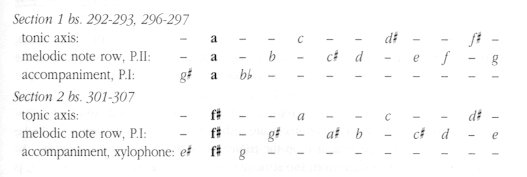
By
this means, symmetrical scales are formed. 49)The
counter-voice appearing in P.II at the beginning of bs. 302-303-304 clinks
glasses with the main voice to make g
chords:
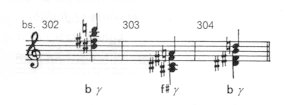
Section
3 (bs. 309-316) undulates on the whole-tone scale, its progress occasionally
being modified by the note row of sections 1 and 2 (P.I bs. 312-315, P.II
bs. 311-314).
The
seductive beauty of section 4 (bs. 317-325) lies largely in the fact that
here, the whole-tone scale condenses into the chromatic scale -
whereas up until now, the greater part of the movement 50)has
tended towards expansion and "dispersal". These moments are quite exceptional,
because they represent the subjective will amidst a process of expansion,
or even disintegration, in which everything, in a numbing fashion, is swallowed
up (in particular at the end of the exposition).
The
strong beats of the melody stay close to the tonic and subdominant axes.
Bs. 326-331 are also a mixture of these two axes (c-eb-f#
+ ab-b-d
= aba chord
51)),
whose colours, dissolving and subsiding in the tam-tam strokes, are burst
by the fugue of the closing theme (b. 332). 52)
Here the characteristic major sixth gestures of the exposition's closing
theme become minor sixths (b. 332 d-bb instead
of d-b b. 105), similar to the major-minor phenomenon (maggiore-minore)
of classical form. The fugue subject itself is built on the dominant
axis: the section as far as b. 335 is nothing else than a broken bba chord:

which
is followed by a related broken db eleventh
chord:

(the
ab turning
point, if we wish, being considered as the dominant of bb),
after which, following a digression towards the dominant (the emphatic
fifth
eb-ab),
we return to the opening axis, a g minor (pentatonic
g) break
down. The subject acquires its particular flavour from the pronounced changes
of pole. An example in bs. 334-335 is the sixth
ab-fb continuation
53)-
extremely distant from the d-bb of
the opening, and more strikingly, the exchange of db
la pentatonic scale in b. 336 for
the counterpole
g la pentatonic scale in b. 338. The
bb and
d
on the triplet beats here jolt to the main d-bb that
opens the subject. Important from the structural standpoint, as later becomes
clear, is the prominently sounding chain of fourths:

Interestingly,
the notes used in the subject - in preparation for the succeeding entry
- include all except a-f, which appear intact to fill in the chromatic
gaps in bs. 339-340.
The
first section of the fugue (bs. 332-359) contains four entries of
the subject; the entries ascend in the circle of fifths, along with
their unchanging repeated counterpoints. The second section (bs.
360-382), with the subject in inversion, continues the subject entries
in the circle of fifths:
|
bb |
f |
c |
g |
d |
|
d |
a |
e |
b |
f# |
| bs. |
332 |
339 |
346 |
353 |
360 |
As
a result of the inversion, the pole d again appears, to which the
subject entries in the alto are chromatically related (bs. 363-365): d-f#,
c#-e#,
c-e,
b-d#. From b. 361 the music proceeds,
it would seem, along classical lines, being embedded in cadential harmonic
progressions: an f# major-minor (a
)
spot emerges that via the B major seventh, or rather ninth chord (b. 362
b-d#-f#-a-c)
and the E major seventh, or rather ninth chord (b. 363 e-g#-b-d-f#)
heads towards A major-minor (b. 364), later leading into the tonic axis
a-c-d#-f#
from the beginning of b. 365. From the end of b. 367 every
triplet beat rests on the axis notes
c-eb-gb-a,
forming the core of an a chord
(c#-gb-a-c-eb-ab).
This
joint tonic intent is broken first by the bass (b. 372), then its rival
the tenor-part (b. 375), the upset harmonic balance then being condensed
with geometric rigour into the curbed ostinato of section II of the
closing theme (bs. 383-416, Vivacissimo):
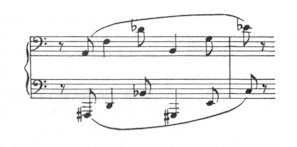
The
two hands in P. I, piling up the familiar minor sixths, together create
a 12-tone construction, each hand having a whole-tone scale (RH
a-f-db-b-g-eb = a-b-db-eb-f-g;
LH the complementary whole-tone scale: f#-g#-bb-c-d-e)
while in vertical succession the 1:3 model: f#-a + d-f
+ bb-db = f#-a-bb-db-d-f
and g#-b +
e-g + c-eb =
g#-b-c-eb-e-g
is heard; these latter each unite two g
chords: f#-a-d-fg +
d-f-bb-dbg
and g#-b-e-gg +
e-g-c-ebg.
The consecutive minor thirds, the minor sixth-based thematic material,
the g
and 1:3 construction, and the whole-tone scale can all be traced back to
GS
principles. In both RH and LH, the first and last notes have a counterpole
layout (a-eb and
f#-c),
and taken together, an axis one. The harmonic structure of this
wildly darting outline changes as follows in bs. 401-405: all the RH strong
beats stick to the tonic axis, while the LH strong beats encompass a complete
circle of fourths (b. 401 a-d-, b. 402 g-c-f-, b. 403 bb-eb-g#-,
b. 404 c#-f#-b-, b. 405 e).
In
essence what has happened is that the complex polyphony of the fugue is
given a schematic continuation as an ostinato of unrivalled intensity,
above and below which are the strata of a new dimension in the infernal
play of light and shadow in P. II and the side drums - importantly, from
the formal point of view, in homophony, in which we recognize again
the chromatically condensed motion of the fugue subject (and section II
of the closing theme in the exposition). In the exposition, the reverse
happened: polyphony grew out of homophony. When analyzing the fugue subject
(section I of the closing theme), its fourth structure was emphasized,
while in the motive-work Vivacissimo (section II of the closing theme),
the structural role of the
minor third and the 1:3 model will
be emphasized. Later, when analyzing bs. 48-56 of movement II, we shall
see that the relationship between the
fourth and the minor third
corresponds to the category of a system of wide
and
narrow
(5:3).
The
flittering fire-snakes 54)(P.II),
floating above the ostinato, coil around the 1:3 model: in bs. 391-393
a-f#-f-d-c#-a#, in bs. 395-397 the same is inverted: f#-a-bb-c#-d-f,
unmistakably outlined by the triplet beats of bs. 399-402: d-f-f#-a-bb-db.
It
is often to be observed that a powerful appearance of the tonic is prepared
by the outline g-b-d-f-ab-bb;
the strong beats of the sixth scales in P.I bs. 405-410 also conform to
this. 55) A further encounter follows in
b. 432. (The strong beats in the treble in bs. 410-412 can be taken as
a G dominant thirteenth chord.)
The
formal rhythm of the exposition (see end of exposition analysis) has been
traced to an
outline forging dynamically ahead, and interrupted at the
point of climax. It has also been shown that this is all related to
the expansion of intervals and chords. From the middle of the movement
(217) onwards, however, all this was seen in inversion, the line,
made up by the units of the overall form, bursting apart and declining
pronouncedly: the flow of the second half of the development dries
up, not to mention the contracting funnel-shaped progressions (217-263);
the first subject is submerged into the second subject, with which it shares
the same tonality, and here similarly we have observed the contraction
of intervals (317); in section II (Vivacissimo) the explosive closing theme
(fugue) is also subjected to intervallic and tonal contraction. 56)
CODA
(bs. 417-443). Again, the counterpoles f#-c mark the divisions of
the coda (bs. 417 and 433). Like a cupola, the demonstrative augmented
first subject towers over the tonic f#-eb-a-c
columns supporting the strong beats of the closing theme's motivic sixths;
the theme, lying along the
eb (from
b. 422) - a (from b. 426) sub-branch of the tonic axis is
complemented by the c (e.g. b. 426) - f# (e.g. b. 428)
main-branch.
The
perfect GS formation of the accompaniment is shown in the motivic
sixths (8), in their axis-construction (3) and in pairs of adjacent or
superimposed minor sixths sounding in a g
relationship (3+5+3).
The
texture of the final dénouement (bs. 433-443) is quite unambiguous:
a development of the first subject in the tonic (P.I c-a-eb)
and with imitations at the fourth (P.II), supported by the tonic eb-f#-c
in the timpani, is chopped up by cruelly agitated xylophone strokes (c!)
together with tonic a and ebg chords
(their trebles being the
c-f#
tonic), thus ensuring that the cadence
can, with formidable certainty of form, call the unbridled elements to
a halt.
18)
The range of the melody also outlines the tonic poles a-d#
(pole-counterpole relationship).
19)
The enharmonically sounding interval is always meant.
20)
"ABC" Title of the book of D. Kosztolányi, Hungarian poet (1885-1936).
21)
We should not be misled by the exchange of parts. We shall return later
to an analysis of the omitted bs. 6-7 and 10-11.
22)
The harmonies in b. 12 are GS formulas: 8 (= minor 6th) - 8 - g
- g
- 8 - w
- w
- (8+8) - 8.
23)
The c#-eb
embracing the d are the exact equivalent of the g-a
surrounding the g#.
24)
If the missing notes of the g
chord are added, the principle underlying the structure of the chords and
their connection becomes symmetry, e.g. at the beginning of b. 37:
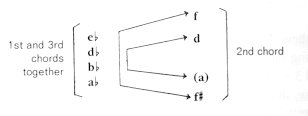
The chords
in bs. 38 and 40 not belonging to this "system" are in fact semitone displacements
of the chords preparatory to them. The deceptive cadence in b. 36: tonic
a minor. N.B. melodically, the first subject resembles the type
found in the 6th Dance in Bulgarian Rhythm.
25)
In connection with the constructive role of the minor second see
the analysis of bs. 2 and 175-194.
26)
The rocket-like progression d-f#-g#-a-c-c#
(bs. 46-47) combines the notes d-c# of the motive’s beginning
with the g# (= ab)
counterpole (in b. 47 the 1:3 outline g#-a-c-c#
is the answer at the fifth to the notes c#-d-f-f#
in the previous bar).
27)
Cf. Debussy: Feux d'artifice.
28)
Cf. the second subject of Beethoven's Waldstein Sonata. The erroneous
b. number (87) has been corrected to 84!
29)
The tonic axis is also reinforced by the melody notes bb
and g, like leading-notes.
30)
There is an e minor broken triad in the treble of bs. 91-94.
31)
See outline "main functional notes" in chapter: Tonal Organization.
32)
Cf. foot-note no. 20
33)
19th century Hungarian poet (1817-1882).
34)
Bartók levelei (Bartók's letters) II, page 80.
35)
Here consideration may be given straightaway to those combinations which
can be created from the symmetrical division of the diminished octave:

The g
chord (d-f-bb-c#)
can be compared to a geometrical parabola, because it is a chordal formula
in which the descant (c#) and the rest of the tones in the chord
are related by squaring. Hence, if we reinterpret the numbers in the series
of squares 1-4-9-16-25-36 etc. (ad inf.) as chromatic intervals compared
to c#, the substitutes will always be these four tones: d-f-bb-c#.
36)
The f final at the end of b. 160 is the answer at the fifth of the
bb
final of section I of the closing theme.
37)
Hungarian aesthete 1890-1983.
38)
Cf. for example Music for Strings movement IV bs. 73-74, 98-99, 113-114,
and 243-244.
39)
E.g. b. 84 e-b + e-g#; b. 95 ab-eb
+ ab-c.
40)
See outline "main functional notes" in the chapter "Tonal Organization".
Let us reflect the 2 ostinatos in such a manner that one note should face
the other; due to the inversion, the c (or f#) becomes the
bisecting point in every case.
41)
Cf. photograph supplement in Volume I of Bartók's letters (Bartók
levelei).
42)
The treble in P. I bs. 163-165 quotes the 1:3 model: e-c#-c-a-g#-f.
P.II b. 166 is a synthesis of B major and the fourth chord e-b-f#.
The digressions at the ends of the phrases (165, 169-170) fall into the
sphere of the subdominant axis, i.e. in relation to the keynote e
they are dominant endings.
43)
bs. 182 and 186-187 are none other than the continuation of bs. 166-181,
the minor seconds condensed into the trill on e (e-f trill
= f-e-f ).
44)
Cf. chapter entitled "Tonal Organization".
45)
In both RH and LH, the descant notes of the parallel fourths are
considered here.
46)
The counterpole of the "a" final is the eb
in b. 200, and that of the "d" final the top ab
in b. 205; the eb
in b. 200, ab
in b. 205 and c# in b. 208 are answers at the fourth.
47)
The g-f#-f in P.I b. 198 derive from the ostinato
(cf. P.II LH).
48)
The tonic axis c-f# appearing in b. 262 causes a change of
centre:

49)
The phrase-ending c that departs from the scheme (b. 295) is the
rhyming fourth of the f in b. 293.
50)
More precisely, until b. 217, the middle of the movement.
51)
The Bartókian dominant of the fugue subject.
52)
The prancing, rearing d-bb
opening of the fugue subject is a chromatic transposition of the
snatches of freely floating eb-b
in bs. 326-330; and the stubbornly forward-looking bb
is the rhyming at the fourth of the second subject's eb
final (b. 330).
53)
Which has the note row of the recapitulation's second subject: ab-bb-c-db-eb-fb
(cf. bs. 292-93, 301-02 as well as 225 plus 227).
54)
Most of the finals of the melody-fragments partner poles with their counterpoles:
bs. 386 eb
and 389 a; bs. 393 a# and 397 e; bs. 402 db
and 403 g; bs. 406 f# and 408 c.
55)
The accented eb-cb
(b. 407) and f-db
(b. 409) in P. I are the relative fourths of the sixths a#-f#
in bs. 413-416.
56)
Concerning the contrary attraction which gravitates from the Vivacissimo
in the direction towards the end of the movement, more will be said later.
NEXT
Contents